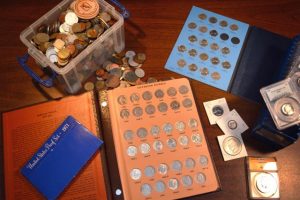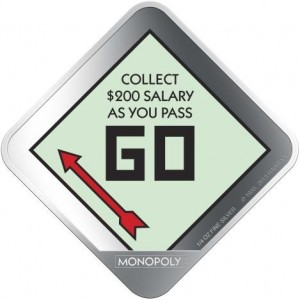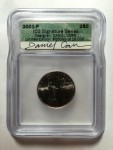 Although I owe you my impressions of the U.S. Mint’s Numismatic Forum, giving it the proper treatment I think it deserves has taken longer than expected. Rather, let me jump ahead to a recurring theme that takes over the conversation on the state of the hobby: Numismatics is a dying hobby of the old.
Although I owe you my impressions of the U.S. Mint’s Numismatic Forum, giving it the proper treatment I think it deserves has taken longer than expected. Rather, let me jump ahead to a recurring theme that takes over the conversation on the state of the hobby: Numismatics is a dying hobby of the old.
MYTH: Electronic transactions have taken over and hard currency is being used less.
FACT: Electronic transactions make up only 13-percent of retail purchases in the United States and 7.1-percent worldwide. Although the pundits like to point out that trillions of dollars change hands electronically, this includes non-consumer-related transactions such as bank transfers from one account to the other using the Automated Clearing House (ACH). If your paycheck is deposited directly into your account, it is transferred using the ACH system.
In real money, the International Monetary Fund estimates that the U.S. Gross Domestic Product (GDP), the total costs for all goods and services, to be $18,561,934,000,000 ($18.561 trillion). If 13-percent of that is electronic retail purchases, that means that $2,413,051,420,000 ($2.413 trillion) is made not using cash. What about the other $16.1 trillion dollars?
 Depending on which report you read, electronic transactions should grow at a rate of 8-10 percent annually. Even if the U.S. GDP is on a pace to grow by only 1.4-percent, adding about $250 billion in electronic transactions will not make a significant dent in the rate of electronic transactions.
Depending on which report you read, electronic transactions should grow at a rate of 8-10 percent annually. Even if the U.S. GDP is on a pace to grow by only 1.4-percent, adding about $250 billion in electronic transactions will not make a significant dent in the rate of electronic transactions.
Of course, the U.S. are not spending $16 trillion in cash transactions, but both the U.S. Mint and the Bureau of Engraving and Printing are on course for record production years. Year-to-date, the U.S. Mint has produced $870,133,500 in circulating coins (not including half-dollar, dollar, and commemorative coins). For Fiscal Year 2015 (October 2014-September 2015) the BEP produced $166,302,000,000 ($166.302 trillion) in currency (not including $2 notes). Although some of the currency does replace worn notes (the BEP reports that 90-percent of $1 notes replace damaged notes) and a significant portion of the $100 notes are shipped to banks overseas, which represents quite a number of transactions.
Although electronic payment options make up 13-percent of all cashless transactions you have to remember that this market barely existed a few years ago. Even as banks and large retailers push to increase the number cashless transaction, there are problems that society faces when moving to a cashless retail system. The biggest problem is one of scale. The United States makes more money, spends more money, trades more money, and has more economic impact than any other country in the world. It is the world’s single largest economy with a strong capitalistic culture where most of the commerce is done with small businesses. Amongst all business, 55-percent of retail merchants are cash-only enterprises. They are too small to consider paying the 3-to-5 percent fees for using a credit card, known as the “swipe fee.” Of those that do take credit cards, at least 36-percent require a minimum purchase.
MYTH: The sharing economy is turning the economic world upside down changing the way we will pay for goods and services.
 FACT: Human beings have been sharing and trading goods and services from the dawn of time. You killed an ox and have the hide left over. I have a lot of fruit I picked that I cannot eat. I will give you an amount of fruit and you give me the hide. Money was created as a medium of exchange when I did not want your fruit but wanted some of the goods someone else had. It was the pre-historic version of the three-way trade.
FACT: Human beings have been sharing and trading goods and services from the dawn of time. You killed an ox and have the hide left over. I have a lot of fruit I picked that I cannot eat. I will give you an amount of fruit and you give me the hide. Money was created as a medium of exchange when I did not want your fruit but wanted some of the goods someone else had. It was the pre-historic version of the three-way trade.
Some of us grew up trading. I remember trading a Mickey Mantle baseball card for a Jerry Koosman and two Donn Clendenon cards —one from Houston and the other from Montreal, just after the Mets traded for Clendenon. I thought I gave the kid a deal because 1969 turned out to be Mantle ’s last year.
What has changed since I made the trade? There has been a tremendous change in technology. While we set the price for the baseball cards we traded, now there are price guides, electronic markets, auctions, and online trading sites. Even in other categories, you might place a classified ad in a newspaper or an advertising rag like PennySaver or something like Uncle Henry’s in Maine. Now there are sites like Craigslist, AirBnB, Uber and Lyft that expands the market.
Pundits like to point to the sharing economy’s growth. The problem with the reports is that this version of the sharing economy has gone from nothing to something with a lot of press coverage. Anytime there is something shiny and new it grabs the attention of the public before they move on to the next distraction.
We share numismatics all of the time. We go to shows and display our collections for competitions. We enter registry sets to try to create a nice collection or even worst collection with the advent of “low ball” sets of coins of very low grades. We blog and read about other’s collections. We post finds to public forums and sometimes bring our collections to show off at club meetings.
Sometimes we even trade. Have you traded a few Barber dimes for a Barber half because you needed the half for your collection? How about three Morgan dollars for an elusive 1921-S Walking Liberty half-dollar?
The only difference between this and the new sharing economy is the lack of computer interface. Sometimes that human interaction is more fun than hiding behind a screen.
MYTH: People, especially millennials are not interested in collecting anything.
FACT: The Hobby and Toy industry is estimated to be a $20 billion business with an estimated growth of 1.6-percent over 2015. Not all of the emphasis is on electronic games and gadgets. One study found that more money is pledged for projects on the crowdfunding site Kickstarter than any other category.One of the fastest growing sectors of this market is board games. While some games do incorporate electronics into their play, this new generation of gamers is finding that social gaming can be as much fun as their online endeavors.
Numismatics has never been a welcoming hobby for the mid-to-lower level collector. Dealers who are older may have a difficult time relating to younger and, frankly, a non-white demographic (see my post about one such incident here). It has created a culture of cranky older Caucasian collectors who think that their way is the only way to collect.
It is not just the dealers. Mainstream publishers put a lot of effort into creating references and collecting supplies that satisfy the market as being pushed by the dealers. Even worse, while the American Numismatic Association does recognize other aspects of numismatics, the fact that most of the Board of Governors are in the coin business with years of experiences in the coin business, that becomes the focus of the ANA.
It is time for the industry and its representative organization, the ANA, to remember that numismatics is more than coins. Currency, exonumia, scripophily, and even military medals are all part of numismatics. Concentrating on coins, especially coverage of high-value sales scares off many novices who may be willing to look at coins as a hobby. When I go out to schools in the Washington, D.C. metro area, I will bring enough Metro (the local transit system) tokens for everyone in the class. After buying a bulk bag of tokens, I have plenty to give away along with the story of how they were once used. But it allows me to show the students that numismatics is more than coins. I explain how I sit at junk boxes and at the tables of token dealers to find items from my hometown of New York. When I show them four pages of 2x2s with tokens and medals from New York and say that in three years I may have spent as much as $200, they seem to understand that you can have fun without spending a lot of money.
MYTH: We lost those who collected the state quarters forever.
 FACT: We also retained a lot of those collectors. Unfortunately, we damaged many others.
FACT: We also retained a lot of those collectors. Unfortunately, we damaged many others.
What made the state quarter program popular was that the way it was administered made everyone a stakeholder. Rather than dictating the design, states were encouraged to allow public participation to help decide on their quarter’s design. Contests and state pride went into the quarters that allowed each state to celebrate their home state. Ordinary people were brought into the process and ceremonies held in each state announcing the designs and on the release of the quarters.
Of course, the state quarters were also the hobby’s demise as television hucksters sold overpriced junk surrounding the sets. Colored coins and “special” sets were sold at high prices with the hint that they would only increase in value. When these people tried to cash in on their “investment” they found they overpaid, became angry, and may not come back. During this time, the ANA was nearly non-existent in the education process as it was undergoing its own internal political battles. Without someone to help stand up for the hobby to help educate the public, the industry suffered.
Although the ANA has improved in many areas, it continues to be about coins with a slant toward classic (pre-1965) and rare coins. The only modern coins that seem to get any amount of respect from the community are commemoratives, bullion, and errors. With the so-called modern era being 52 years old, it is time for the old and crusty of the numismatics industry to either get on board with that it is new to the new collectors or maybe it is time to consider retirement.
The lesson I have learned in numismatics as well in my business of buying and selling collectibles is that in order to expand any hobby it has to be made into something personal. Sports collectibles sell memories of your heroes. Space collectibles sell the mystique of outer space. Automobilia seems to have a fascination for a lot of people even as what was considered modern nameplates like Plymouth and Pontiac have gone the way of DeSoto and American Motors.
Hobbies have to also be interesting. Is it really interesting to collect a series of all of the same coins where the only difference is the date or mintmark? Again, why does a collection have to be biased for coins? Can someone have fun collecting So-called dollars, transportation tokens, or even unusual coins? I think about how much fun Charmy Harker might have had to put together her award-winning exhibit Penny Potpourri with things made out of pennies. If you have not seen her exhibit, you can find images here. It has to be one of the best exhibits I have ever seen because it is unusual. I like things that are different.
In order to get people interested in the hobby, you cannot introduce it to them by showing a 1909-S VDB Lincoln cent or a 1937-D 3-Legged Buffalo nickel as an example. Not only are these coins difficult to find and less affordable, but not everyone may be interested. I like to use my two-pages of 2×2 holders with a set of transportation tokens with every letter of the alphabet cut out of the center, except “Q” and “Z,” along with some that have shapes. When I tell someone I paid around $50 for the initial investment and can buy most tokens for less than $5 each, they want to know how they could get started.
Here are some ideas to help you start a new collection. You can only use these if you do so by recruiting a friend or relative who is not currently part of the hobby:
- If you want to start with coins, go find a folder of currently circulating coins and see who can fill their folder first only from pocket change. I recommend either Lincoln Memorial cents, which can be interesting finding S-mint circulating cents on the east coast, or Jefferson nickels (for fun, use Whitman Jefferson Nickel folder #2).
- Another idea for collecting coins is to make a collection based on a theme. Ideas for themes can be the year you were born, coins with an animal like buffalos, or create a type set that represents some of the subtle changes in a long series like Lincoln cents.
- There are more to exonumia than transportation tokens. If your state issued tax tokens in the early part of the 20th century then how about finding examples for a collection. Tokens are still being created for gaming, casino chips, parking tokens, or store tokens the pre-cursor to paper coupons. Advertising tokens can be a fun way to collect your hometown. Tokens with themes, shapes, and cutouts can be a lot of fun.
- Go beyond tokens to encased coins. Encased coins have been used as a private commemorative, advertising, and I even found one for an electric supply company that promised money off if you returned it to their store.
- You can collect elongated cents, also called squished pennies, from almost anywhere. Recently, I found a machine in the Philadelphia Mint’s gift shop. For 51-cents, each I was able to buy two souvenirs. Collecting elongateds also helps you keep the record of where you have been.
And I didn’t mention currency or scripophily. One cool idea would be to collect stock certificates representing what you might find on a Monopoly game board.
If you have other suggestions, send it as a comment!
Now go out and start a collection. Recruit a friend and do it together.
Selection of my New York collection
- 1936 Long Island Tercentenary Half-Dollar
- 1983 Brooklyn Bridge Centennial Medal issued by Brooklyn Union Gas
- Medal from the opening of the Brooklyn Bridge in 1883
- 1956-D Encased Cent from the Chase Money Museum
- A check from the First National Bank of Inwood (NY)
- 50th Anniversary medal from the Inwood Country Club.
- 1938 Encased Cent from the First National Bank of Inwood (NY)
- 1984 LIRR Sesquicentennial Bronze Medal
- TBTA Toll Token
- Reverse of the Triborough Bridge and Tunnel Authority Rockaways resident token.
- New York City Type 2 Subway Token error. It’s missing the punched out “Y”
- 2000-P New York quarter with Daniel Carr’s autograph on ICG label
- 2000-D New York quarter with Daniel Carr’s autograph on ICG label
- Series 2003 $2 Star Note from the Federal Reserve Bank of New York. Rosario Marin/John Snow signatures.
- Series 2013 Uncirculated $1 Federal Reserve Note from the Federal Reserve Bank of New York
- A&S Charge Token with account number
- Coin collecting image courtesty of about.com.
- Quarter map image courtesy of the Continental Mint.


















